|
Now that the new school year has begun, parents
want to make sure that their kids start every day off the right way – and that doesn’t just mean fueling their
bodies, but it also means feeding their brains the right foods so that they are best able to learn. This is what Kids
Heart Felt Health calls “the Breakfast “A”dvantage.”
You can jump start the learning
process by helping your kids choose the right foods at breakfast time. Forgo donuts, pastries, and cereals with 10 grams
or more of sugar: these breakfast foods will “drain” their brains of glucose – which they need to
stay focused and to learn while at school. Instead, make sure your kids are eating whole grains, fiber, and protein
at breakfast time.
This month’s recipe features a whole grain, fiber-filled pancake in the form of a muffin
– so, even on those busy mornings, you can be sure that your child does not leave home without eating breakfast.
Just grab one or two muffins “to go” and your child will start the school day off the right w”A”y!
|
 |
 APPLE CINNAMON RAISIN PANCAKE MUFFINS
(Makes 8 muffins) Ingredients:
½ cup flour
½ cup oatmeal flour [make this flour yourself by blending old fashion
oatmeal in a food processor or blender – do not use instant oatmeal here)
1 Tablespoon baking powder
½ tsp. baking soda
¼ tsp. salt
1 tsp. brown sugar or 1 tsp. stevia
2 tbsp. maple syrup
2/3 cup buttermilk
1 egg
2 tbps. melted lowfat butter
½ cup diced
apple (leave skin on)
½ cup raisins
1 tsp. cinnamon
INSTRUCTIONS:
• Preheat oven at 375F°
• Combine all dry ingredients thoroughly in a Ziploc bag (flour,
oatmeal, baking soda, baking powder, salt, brown sugar).*
• In a separate bowl, combine all liquid ingredients
(buttermilk, maple syrup, egg, melted butter)
• Pour dry ingredients into liquid ingredients and beat with
a fork to get lumps out of batter
• Add fresh apple bits, raisins, and cinnamon and fold into batter
• Spray
muffin tins with cooking spray. Pour batter into muffin tins.
• Bake for 12-14 minutes. Insert
a toothpick into center of muffin. If it comes out clean, muffin is done.
*This can be done ahead of time and kept
in the freezer until needed.
|
 |
|
|
Why is Breakfast so Important?
According to some reports, nearly half of all children do not eat breakfast every day. Why
is breakfast the most important meal of the day? And what is the connection between breakfast and learning?
The word “breakfast” literally means “breaking
the fast.” Now, let’s think about how long a typical child has “fasted” by the time he or she
wakes up in the morning. For example, if a child eats dinner at 6:00 p.m., goes to bed without eating anything else,
and sleeps until 6:00 a.m., he or she has not eaten (has “fasted”) for 12 hours [that’s half the day!].
If a child does not eat breakfast before school and waits until noon to eat, his or her body would have “fasted”
for 18 hours [that is ¾, or 75%, of a day that this child hasn’t eaten anything!]
When a person doesn’t eat anything for a long time, blood sugar levels can drop, which means
that in the morning, people lack energy and need food to re-energize themselves. Children unfortunately often crave
simple carbohydrates with fast-acting sugars, like donuts, pastries, or sugar-filled cereals. Not only do these “sugary”
foods lack nutritional value, but they also put kids at a “D”isadvantage while learning. This is because
the brain needs “glucose” to function optimally. Glucose, however, cannot be stored in the brain.
“Sugary” foods like donuts and pastries enter the bloodstream quickly, causing a rise in insulin levels in the
body, which “drains” the brain of glucose that is needed for optimal learning.
A child’s brain needs the right fuel in the morning to help him or her focus and perform well
in school.
Studies
have shown that there are significant differences between children who eat breakfast and those who do not:
Children who EAT Breakfast
• Do better in school
• Have higher math & reading scores
• Pay
attention better in school
• Are more alert, energetic
• Are less less irritable,
less moody, and less anxious
• Have less behavioral problems
• Go to the nurse’s
office at school less often
• Have higher attendance records
• Are more likely to
make better food choices
• Are more likely to eat foods with essential minerals, calcium, vitamins, and
nutrients
• Are less likely to gain weight; more likely to maintain normal body weight
• Have
lower cholesterol levels, important for heart health
• Have less incidence of tooth decay
A GOOD BREAKFAST FORMULA = PROTEIN + FIBER
• Protein
helps build and maintain the body’s muscles, skin, and hair
• Fiber satisfies hunger, aids digestion,
and makes children feel more “full” until lunchtime
OCTOBER RECIPES - WHOLE WHEAT PIZZAS, QUICK VEGGIE TOMATO
SAUCE, CHIA SEED JELLO
NOVEMBER
RECIPES - KALE & POTATO SOUP, KALE CHIPS, GARLIC PARMESAN PITA CRACKERS
DECEMBER
RECIPES - MINTY BEAN BROWNIES, CHOCOLATE COVERED PRETZELS
FEBRUARY RECIPE - CHOCOLATE BEETROOT CUPCAKES
MARCH RECIPE - QUINOA FRUIT SALAD
JULY RECIPE - ZUCCHINI SQUASH "SPAGHETTI"
TOMATO BASIL PESTO GRILLED CHEESE & WATERMELON PEACH SLUSHIE
|
